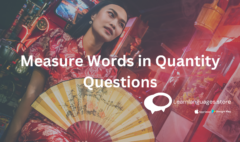Mastering the “Also” Adverb “Ye” in Chinese Grammar
Mastering the “Also” Adverb “Ye” in Chinese Grammar
Estimated reading time: 3 minutes

The adverb “ye” (也) in Chinese is equivalent to “also” or “too” in English. It’s a versatile word that enhances the expressiveness of sentences. Let’s explore its usage, exceptions, and grammar structure.
1. Ye with Verb Phrases (Ye ke sath kriya vakyon)
Structure (Vyavastha):
Subj. + Ye + Verb / [Verb Phrase]
Examples (Udaharan):
- Wǒ yě xǐhuan.
I also like it.
मैं भी इसे पसंद करता हूँ। - Tā yě shì xuésheng.
She is also a student.
वह भी एक छात्र है। - Tāmen yě huì qù ma?
Are they also going?
क्या वे भी जा रहे हैं?
A Note on the Negative Form (Nakaratmak Roop Par Nootan)
In Chinese, whether the sentence is positive or negative, “ye” is placed before the negative part.
2. Ye with Adjectives (Ye ke sath visheshtaon)
Structure (Vyavastha):
Subj. + Ye (+ Adv.) + Adj.
Examples (Udaharan):
- Nǐ yě hěn gāo.
You are also tall.
तुम भी लंबे हो। - Zhè zhǒng jiǔ yě hěn hǎohē.
This kind of alcohol is also good.
इस प्रकार का शराब भी अच्छा है। - Háizi yě kěyǐ hējiǔ ma?
Can kids drink alcohol too?
क्या बच्चे भी शराब पी सकते हैं?
3. Expressing “Me Too” with Ye (Ye ke sath “Me Too” vyakt karna)
To express “me too,”
use the structure :
“wǒ yě shì”
I am too
Structure (Vyavastha):
Wǒ yě shì.
Examples (Udaharan):
- Wǒ yě shì Měiguó rén.
I am also an American.
मैं भी अमेरिकी हूं। - Wǒ yě xǐhuan.
I like it too.
मुझे भी यह पसंद है।
By understanding the usage of “ye” in different contexts, you can enhance your Chinese language skills. Practice these structures in various sentences to become proficient in expressing “also” or “too” accurately.
Learn Languages Store
Vashi,
Email: services@learnlanguages.store










